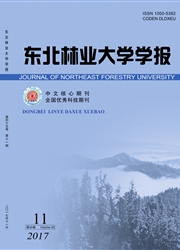

 中文摘要:
中文摘要:
采用二次热解析仪与GC—FID联用技术对沈阳地区8种典型绿化树种生物源挥发性有机物(BVOCs)的排放速率进行了观测和研究。结果表明:银中杨和垂柳的BVOCs排放量显著高于其它6种树木,排放速率分别为97.63和18.24μg·(g·h)^-1。阔叶树中银中杨、垂柳、丁香、水腊主要排放异戊二烯,排放速率分别为97.33、17.71、3.78、0.13μg·(g·h)^-1,榆树、皂角、银杏主要排放柠檬烯,排放速率分别为0.60、1.64、2.00μg·(g·h)^-1;而针叶树油松以排放α-蒎烯为主,排放速率为2.25μg·(g·h)^-1。
 英文摘要:
英文摘要:
An experiment was conducted to determine the emission rates of Biogenic Volatile Organic Compounds (BVOCs) from eight major afforestation tree species in Shenyang area by twice thermal desorption instruments using GC-FID techniques. Results showed that the emission rates of BVOCs from Populus alba x P. berolinensis and Scdix babylonica were 97.63 and 18.24 μg·g^-1·h^-1 respectively, which were significantly higher than those of the other six tree species. The deciduous trees, such as P. alba × P. berolinensis, S. babylonica, Syringa oblata and Ligustrum obtusifolium, mainly emitted isoprene, and their emission rates were 97.33, 17.71,3.78, 0. 13 μg·g^-1·h^-1, respectively; while Ulmws pumila, Gleditsiajaponica and Ginkgo bilotm predominantly emitted linaonene, and their emission rates were 0. 60, 1.64, 2.00 μg·g^-1·h^-1, respectively. The coniferous trees like Pinus tabulaeformis mainly released cz-pinene, and its emission rate was 2.25 μg·g^-1·h^-1.
 同期刊论文项目
同期刊论文项目
 同项目期刊论文
同项目期刊论文
 Effects of Elevated Ozone on Photosynthetic CO2 Exchange
and Chlorophyll a Fluorescence in Leaves of
Effects of Elevated Ozone on Photosynthetic CO2 Exchange
and Chlorophyll a Fluorescence in Leaves of Influence of elevated carbon dioxide and ozone on the foliar nonvolatile terpenoids in Ginkgo biloba
Influence of elevated carbon dioxide and ozone on the foliar nonvolatile terpenoids in Ginkgo biloba Solar activity, Global Surface Air Temperature Anomaly and Pacific Decadal Oscillation signals obser
Solar activity, Global Surface Air Temperature Anomaly and Pacific Decadal Oscillation signals obser Impact of Elevated CO2 and O3 Concentrations on Biogenic
Volatile Organic Compounds Emissions from G
Impact of Elevated CO2 and O3 Concentrations on Biogenic
Volatile Organic Compounds Emissions from G 期刊信息
期刊信息
